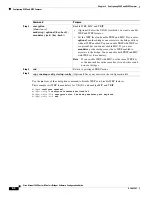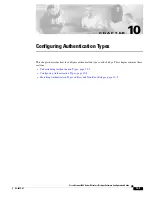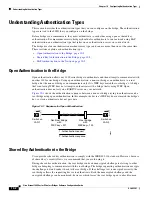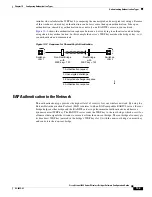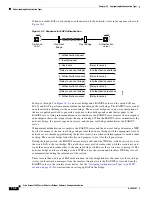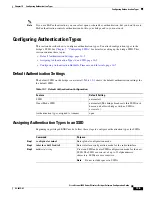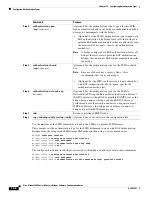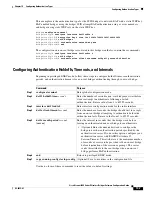
11-4
Cisco Aironet 1400 Series Wireless Bridges Software Configuration Guide
OL-4059-01
Chapter 11 Configuring RADIUS and Servers
Configuring and Enabling RADIUS
Configuring RADIUS
This section describes how to configure your bridge to support RADIUS. At a minimum, you must
identify the host or hosts that run the RADIUS server software and define the method lists for RADIUS
authentication. You can optionally define method lists for RADIUS authorization and accounting.
A method list defines the sequence and methods to be used to authenticate, to authorize, or to keep
accounts on a non-root bridge. You can use method lists to designate one or more security protocols to
be used, thus ensuring a backup system if the initial method fails. The software uses the first method
listed to authenticate, to authorize, or to keep accounts on non-root bridges; if that method does not
respond, the software selects the next method in the list. This process continues until there is successful
communication with a listed method or the method list is exhausted.
You should have access to and should configure a RADIUS server before configuring RADIUS features
on your bridge.
This section contains this configuration information:
•
Default RADIUS Configuration, page 11-4
•
Identifying the RADIUS Server Host, page 11-4
(required)
•
Configuring RADIUS Login Authentication, page 11-7
(required)
•
Defining AAA Server Groups, page 11-9
(optional)
•
Configuring RADIUS Authorization for User Privileged Access and Network Services, page 11-11
(optional)
•
Starting RADIUS Accounting, page 11-12
(optional)
•
Configuring Settings for All RADIUS Servers, page 11-13
(optional)
•
Configuring the Bridge to Use Vendor-Specific RADIUS Attributes, page 11-13
(optional)
•
Configuring the Bridge for Vendor-Proprietary RADIUS Server Communication, page 11-14
(optional)
Note
The RADIUS server CLI commands are disabled until you enter the
aaa new-model
command.
Default RADIUS Configuration
RADIUS and AAA are disabled by default.
To prevent a lapse in security, you cannot configure RADIUS through a network management
application. When enabled, RADIUS can authenticate users accessing the bridge through the CLI.
Identifying the RADIUS Server Host
Access point-to-RADIUS-server communication involves several components:
•
Host name or IP address
•
Authentication destination port
•
Accounting destination port
•
Key string
•
Timeout period

